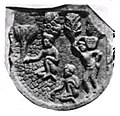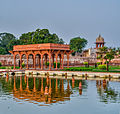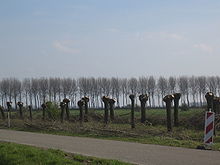The Gardening Portal

Gardening is the process of growing plants for their vegetables, fruits, flowers, herbs, and appearances within a designated space. Gardens fulfill a wide assortment of purposes, notably the production of aesthetically pleasing areas, medicines, cosmetics, dyes, foods, poisons, wildlife habitats, and saleable goods (see market gardening). People often partake in gardening for its therapeutic, health, educational, cultural, philosophical, environmental, and religious benefits. Gardening varies in scale from the 800 hectare Versailles gardens down to container gardens grown inside. Gardens take many forms, some only contain one type of plant while others involve a complex assortment of plants with no particular order. (Full article...)
Horticulture is the science and art of growing fruits, vegetables, flowers, or ornamental plants. Horticulture is commonly associated with the more professional and technical aspects of plant cultivation on a smaller and more controlled scale than agronomy. There are various divisions of horticulture because plants are grown for a variety of purposes. These divisions include, but are not limited to: propagation, arboriculture, landscaping, floriculture and turf maintenance. For each of these, there are various professions, aspects, tools used and associated challenges; Each requiring highly specialized skills and knowledge of the horticulturist. (Full article...)
General images -
Selected article -
Pollarding is a pruning system involving the removal of the upper branches of a tree, which promotes the growth of a dense head of foliage and branches. In ancient Rome, Propertius mentioned pollarding during the 1st century BCE. The practice has occurred commonly in Europe since medieval times, and takes place today in urban areas worldwide, primarily to maintain trees at a determined height or to place new shoots out of the reach of grazing animals.
Traditionally, people pollarded trees for one of two reasons: for fodder to feed livestock or for wood. Fodder pollards produced "pollard hay" for livestock feed; they were pruned at intervals of two to six years so their leafy material would be most abundant. Wood pollards were pruned at longer intervals of eight to fifteen years, a pruning cycle tending to produce upright poles favored for fencing and boat construction. Supple young willow or hazel branches may be harvested as material for weaving baskets, fences, and garden constructions such as bowers. Nowadays, the practice is sometimes used for ornamental trees, such as crape myrtles in southern states of the US. (Full article...)
Selected image
Related portals
Did you know -
- ... that former New Jersey first lady Lucinda Florio restored the Italianate gardens at Drumthwacket?
- ... that the Cranford Rose Garden at Brooklyn Botanic Garden was cited as having 1,200 varieties of roses?
- ... that the Shakespeare garden in Wessington Springs, South Dakota, was the first of its kind in the state?
- ... that Parimal Garden in Ahmedabad has scrap-metal monkeys?
- ... that The Lord of the Ice Garden, a Polish novel series mixing elements of fantasy and science fiction, has been compared to The Witcher?
- ... that Ardwall House has a garden ornament in the form of an early mediaeval Pictish slab inscribed with a Celtic cross?
- ... that Bulandshahr's ornate Garden Gate was built on the site of a "filthy" drainage ravine?
- ... that much of what we know of medieval gardens comes from illuminated manuscripts?
Things you can do
- This list is transcluded from the tasks list page. To edit the list, click here
 |
Here are some tasks awaiting attention:
|
WikiProjects
Topics
Categories
Associated Wikimedia
The following Wikimedia Foundation sister projects provide more on this subject:
-
Commons
Free media repository -
Wikibooks
Free textbooks and manuals -
Wikidata
Free knowledge base -
Wikinews
Free-content news -
Wikiquote
Collection of quotations -
Wikisource
Free-content library -
Wikiversity
Free learning tools -
Wiktionary
Dictionary and thesaurus

































































































